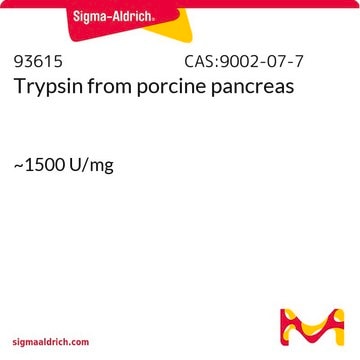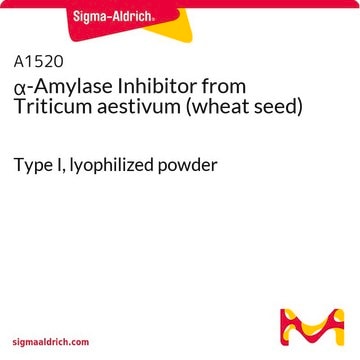10080
α-Amylase from hog pancreas
powder, ~50 U/mg
Synonym(s):
α-Amylase Enzyme
Sign Into View Organizational & Contract Pricing
All Photos(1)
About This Item
Recommended Products
biological source
hog pancreas
form
powder
specific activity
~50 U/mg
storage temp.
−20°C
General description
Pancreatic α-amylase is produced by the pancreatic acinar cells and released into the duodenum. It is a major molecule of pancreatic fluid.
Application
α-Amylase from hog pancreas has been used:
- in the in vitro digestion system to study the hydrolysis of pea globulins
- in vitro α-amylase inhibition study
- to prepare digestive juice (salivary juice) for the in vitro model of the human digestion system
Biochem/physiol Actions
α-Amylase is a starch hydrolase, for glucose production, important for energy acquisition. It catalyzes the hydrolysis of α-1,4-glycosidic linkages in starch to form glucose, maltose, and maltotriose units. In mammals, α-amylase regulates the sugar assimilation by reducing the glucose uptake by Na+/glucose cotransporter 1 (SGLT1) and stimulating glycoprotein N-glycans mediated starch digestion. α-Amylase inhibitors are associated with the treatment of type 2 diabetes mellitus. α-Amylases are widely known industrial enzymes used in food, detergent, textile, fermentation, and pharmaceutical industries.
Unit Definition
1 U corresponds to the amount of enzyme which liberates 1 μmol maltose per minute at pH 6.9 and 25°C (starch acc. to Zulkowsky, Cat. No. 85642, as substrate)
Other Notes
Optimum pH and temperature 6.9 and 53 °C, respectively; calcium is required for activity and also prevents degradation by trypsin; Characterization.
Signal Word
Danger
Hazard Statements
Precautionary Statements
Hazard Classifications
Resp. Sens. 1
Storage Class Code
11 - Combustible Solids
WGK
WGK 1
Flash Point(F)
Not applicable
Flash Point(C)
Not applicable
Personal Protective Equipment
dust mask type N95 (US), Eyeshields, Gloves
Certificates of Analysis (COA)
Search for Certificates of Analysis (COA) by entering the products Lot/Batch Number. Lot and Batch Numbers can be found on a product’s label following the words ‘Lot’ or ‘Batch’.
Already Own This Product?
Find documentation for the products that you have recently purchased in the Document Library.
Customers Also Viewed
Paula Monteiro de Souza et al.
Brazilian journal of microbiology : [publication of the Brazilian Society for Microbiology], 41(4), 850-861 (2010-10-01)
Amylases are one of the main enzymes used in industry. Such enzymes hydrolyze the starch molecules into polymers composed of glucose units. Amylases have potential application in a wide number of industrial processes such as food, fermentation and pharmaceutical industries.
Muhammad H Alu'datt et al.
Food chemistry, 240, 784-798 (2017-09-28)
This investigation was performed to assess the effects of sonication on the structure of protein, extractability of phenolics, and biological properties of isolated proteins and protein co-precipitates prepared from brewers' spent grain and soybean flour. Scanning electron micrographs revealed that
Kimie Date et al.
The Journal of biological chemistry, 290(28), 17439-17450 (2015-05-30)
α-Amylase, a major pancreatic protein and starch hydrolase, is essential for energy acquisition. Mammalian pancreatic α-amylase binds specifically to glycoprotein N-glycans in the brush-border membrane to activate starch digestion, whereas it significantly inhibits glucose uptake by Na(+)/glucose cotransporter 1 (SGLT1)
Yufang Liu et al.
Journal of agricultural and food chemistry, 65(9), 1865-1873 (2017-02-15)
Health-promoting effects of kefir may be partially caused by bioactive peptides. To evaluate their formation or degradation during gastrointestinal digestion, we monitored changes of the peptide profile in a model of (1) oral, (2) gastric, and (3) small intestinal digestion
Mechanistic study on inhibition of porcine pancreatic α-amylase using the flavonoids from dandelion.
Yanmei Huang et al.
Food chemistry, 344, 128610-128610 (2020-11-23)
This study was designed to investigate quantitatively the inhibition and molecular mechanism of pancreatic α-amylase exhibited by flavonoids from dandelion to reveal its potential use in relieving postprandial hyperglycemia. The results show that the flavonoids reversibly inhibited the α-amylase in
Our team of scientists has experience in all areas of research including Life Science, Material Science, Chemical Synthesis, Chromatography, Analytical and many others.
Contact Technical Service










